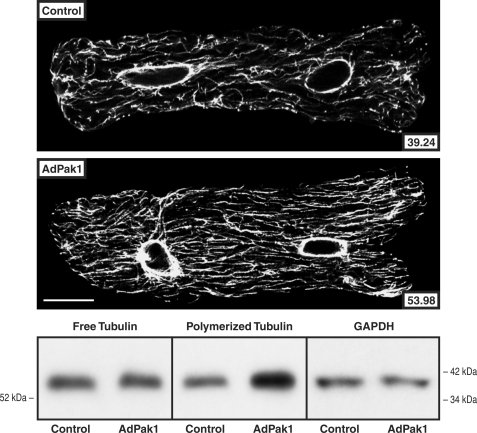FIGURE 2.
Cardiomyocyte free and polymerized tubulin after AdPak1 infection. These confocal micrographs and immunoblots were prepared from cultured quiescent adult feline cardiomyocytes infected 48 h earlier with AdPak1, an adenovirus encoding constitutively active Pak1, at a multiplicity of infection of ∼1. Control cells were infected at the same multiplicity of infection with AdβGal, an adenovirus encoding bacterial β-galactosidase, and additional controls for these adenovirus infection data are provided in supplemental Fig. S1. The greater microtubule network density and concentration of polymerized tubulin in the AdPak1-infected cells is apparent. A monoclonal anti-β-tubulin antibody (clone DM-1B; Abcam) was used for the micrographs and immunoblots, and for the immunoblot loading control, a monoclonal anti-GAPDH antibody (clone 6C5; Upstate Biotech) was used for the same samples as used for free tubulin. The number inset into each micrograph gives the mean pixel intensity (white level) of the microtubule network within the boundary of that cell; each micrograph is a single 0.1-μm confocal section taken at the level of the nuclei. For this and two other immunoblots, the densitometric ratio of AdPak1/control signals was 0.96 ± 0.05 for free tubulin and 2.19 ± 0.13 for polymerized tubulin. Scale bar, 20 μm.

